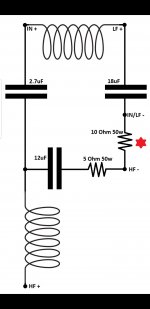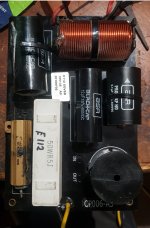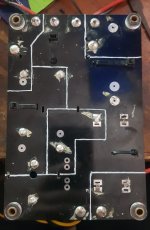The amplifier should be checked for oscillation. Tweeters are generally fragile, and don't like square waves (hard clipping), but to have a resistor rated for 20W in the particular application fail and open VC in the tweeter screams bad amplifier, or extreme abuse..
It could also be a symptom of a rather small amplifier pushed way too hard, but the component damage says otherwise?
Is the amplifier suitable for this speaker load? (i.e. cheap amp designed for 8 ohm loads minimum with a 4 ohm speaker)
The only speakers I have seen damaged as severely were subjected to a steady dose of heavy metal, industrial, DCM, or electronic at very high levels.. LOL (I listen to the last 3, but not the 1st. 😀 )
It could also be a symptom of a rather small amplifier pushed way too hard, but the component damage says otherwise?
Is the amplifier suitable for this speaker load? (i.e. cheap amp designed for 8 ohm loads minimum with a 4 ohm speaker)
The only speakers I have seen damaged as severely were subjected to a steady dose of heavy metal, industrial, DCM, or electronic at very high levels.. LOL (I listen to the last 3, but not the 1st. 😀 )
Last edited:
400VDC cap shorted?
Heat? Maybe the board is mounted in upright position inside the cabinet?
Last edited:
My assumption is it was scorched/burned by the flaming resistor. It does not have to even be vertical if the flame event is violent enough, I have seen them go off like blow torches. There really should not be much inside them that is combustible but I assume the extreme heat is degrading something that is producing a flammable gas. Some of these resistors have fiberglass cores.
It's hard to see as the PCB as it has a thick layer of black varnish over it so it was hard to see the tracks and I didn't have a multimeter at the time but correct me if it doesn't look right but I tried to work out the schematic below. I know the resistors are in the correct position at the tweeter.
Attachments
I believe the inductor on lower left corner of your schematic is an error, it shouldn't connect in series to the tweeter.
Can you take photo of the crossover front and back like the example below? Perhaps we can draw out a correct schematic.

Can you take photo of the crossover front and back like the example below? Perhaps we can draw out a correct schematic.
If you connect HF+ to IN-/LF- it makes sense. 2nd order low pass, 3rd order high with L-pad and reversed polarity.
Does this help? While 50W is a lot for a speaker (what is this speaker?), as Rayma points out the replacement resistor wasn't installed correctly. Who knows what damage there is.
Does this help? While 50W is a lot for a speaker (what is this speaker?), as Rayma points out the replacement resistor wasn't installed correctly. Who knows what damage there is.
Thanks guys so much for all your replies!!!
Sorry that last diagram is probably incorrect 🙁
And also the board varnish is so thick and black it's very hard to see and worse in a photo so I had to use a paint pen so it would show up on camera.
I've made another drawing hopefully it makes more sense.
Is this a possibility? since the 10ohm resister is across the HF driver and if the tweeter blows the guys would think it needs way more top end thus cranking up the high frequencies on the mixer more which isn't doing anything audible except heating up the resistor more until it blows?
Sorry that last diagram is probably incorrect 🙁
And also the board varnish is so thick and black it's very hard to see and worse in a photo so I had to use a paint pen so it would show up on camera.
I've made another drawing hopefully it makes more sense.
Is this a possibility? since the 10ohm resister is across the HF driver and if the tweeter blows the guys would think it needs way more top end thus cranking up the high frequencies on the mixer more which isn't doing anything audible except heating up the resistor more until it blows?
Attachments
A real wirewound 10 ohm 50 W resistor doesn't have aluminum case, no fins and weighs > 150 G. They tend to be black brown or white, not gold. I get mine at surplus houses. Speaker supply houses in AUST could carry them. The gold aluminum case ones, and the newer TO-220 ones, require a heat sink to perform to nominal watts, something you don't have room for. All the pro electronic distributors in the US have dropped the real wirewound resistors.
If the either driver shorts, the components could be overloaded & burn again. I'd put a fast flow (normal) 3ag fuse in series with this crossover input, current below the watt rating of the speaker. sqrt(P/Z)=I where P is speaker watt rating, Z is speaker nominal impedance (4 or 8) and I is current at rated watts. Buy a fuse rated I. So if you had a 100 w rated speaker (consumer grade, not PA) at 8 ohms I would be 3.5 amps.
If somebody on input may drop a microphone or walk on an uneven floor into a microphone (too much bass) or make a feedback screech with a microphone (too much highs) you would want to install additional protection as the tungsten bulb limiter series the tweeter or a ~33 uf cap series the woofer to block the lows. Silk dome tweeters IMHO are not suited for work with microphones. My hifi speaker with 3" cone tweeter has survived okay in limited PA service.
If the either driver shorts, the components could be overloaded & burn again. I'd put a fast flow (normal) 3ag fuse in series with this crossover input, current below the watt rating of the speaker. sqrt(P/Z)=I where P is speaker watt rating, Z is speaker nominal impedance (4 or 8) and I is current at rated watts. Buy a fuse rated I. So if you had a 100 w rated speaker (consumer grade, not PA) at 8 ohms I would be 3.5 amps.
If somebody on input may drop a microphone or walk on an uneven floor into a microphone (too much bass) or make a feedback screech with a microphone (too much highs) you would want to install additional protection as the tungsten bulb limiter series the tweeter or a ~33 uf cap series the woofer to block the lows. Silk dome tweeters IMHO are not suited for work with microphones. My hifi speaker with 3" cone tweeter has survived okay in limited PA service.
Last edited:
- Home
- Loudspeakers
- Multi-Way
- Resistor shot flame in crossover :O





